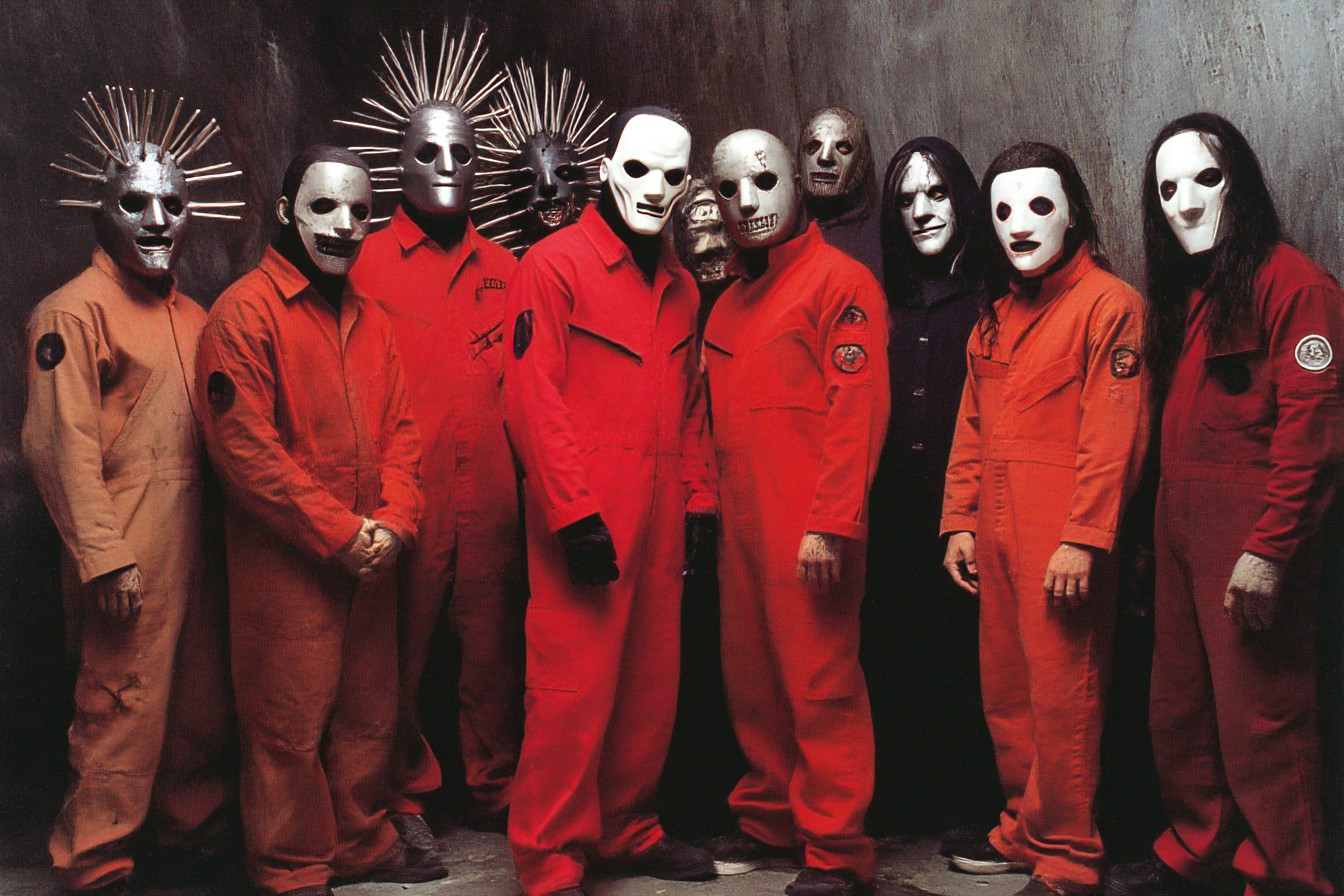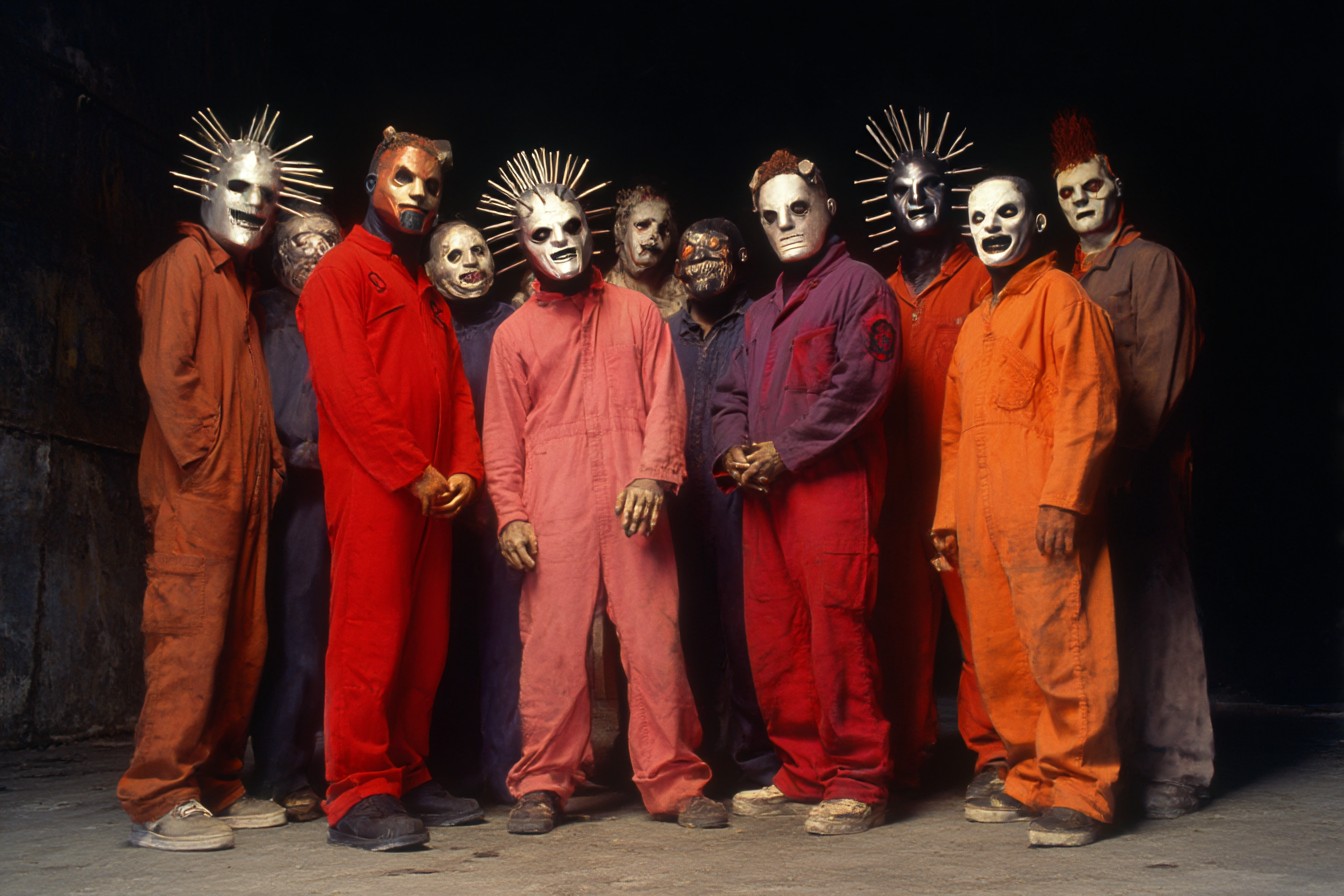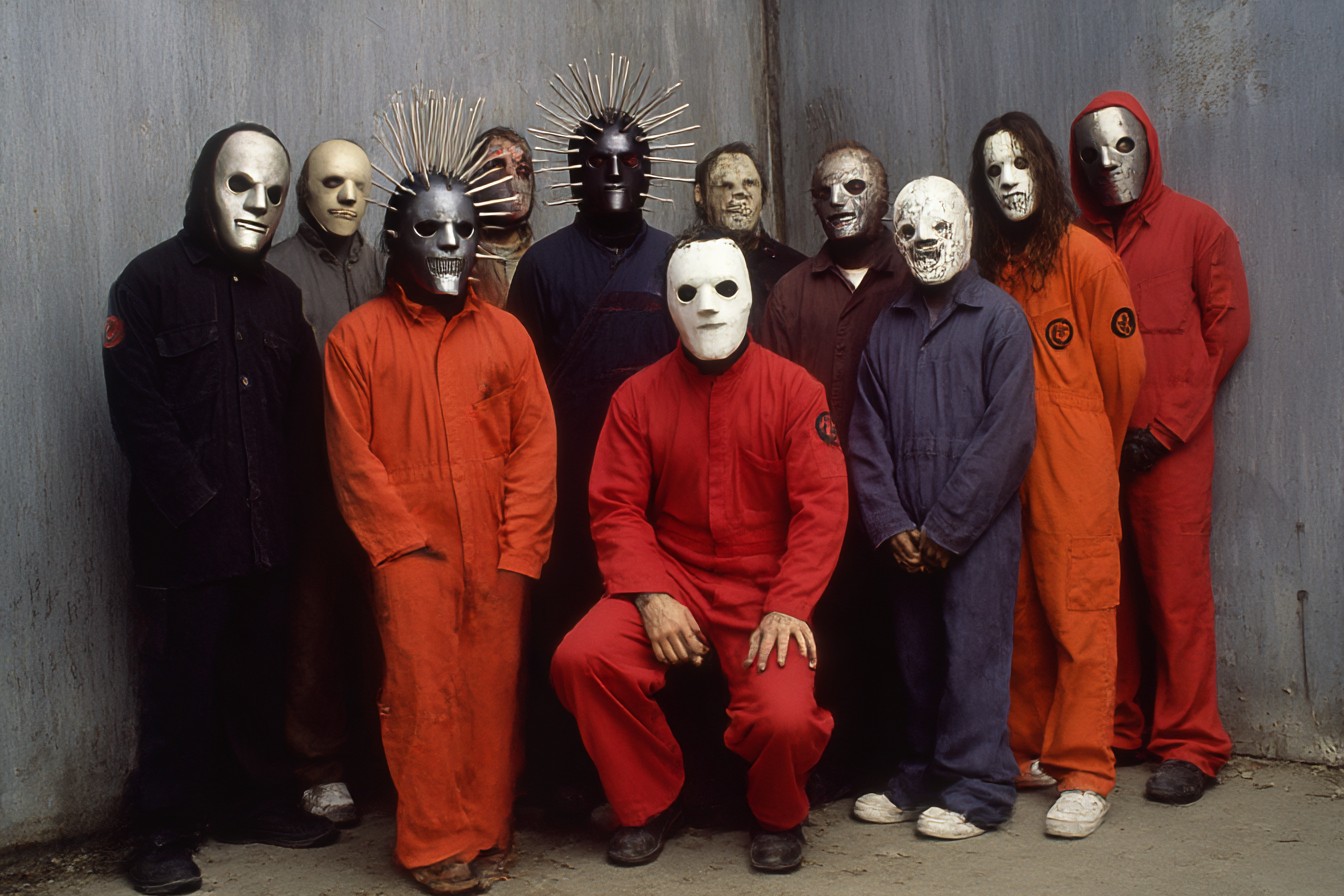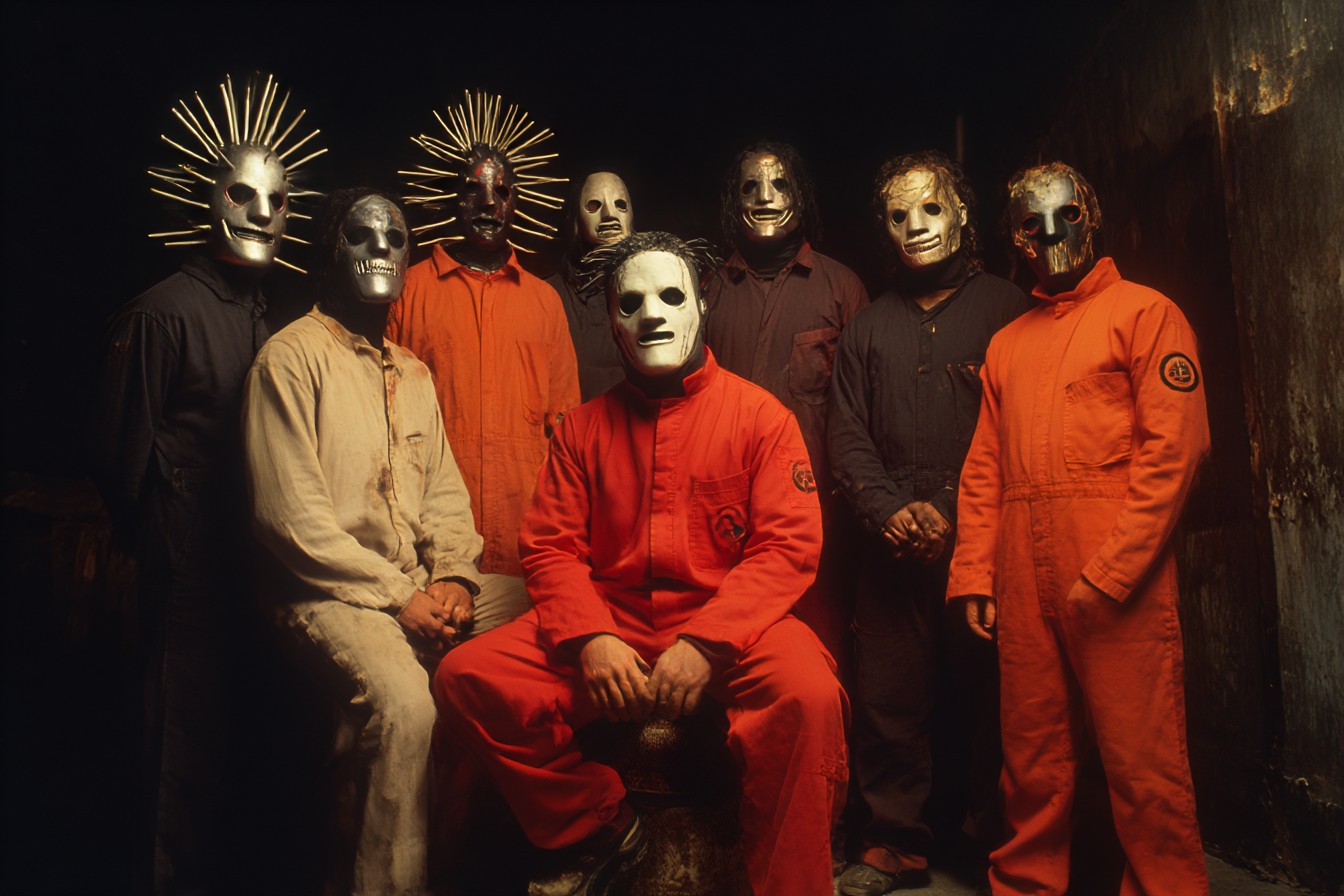I first heard Slipknot on a Tuesday night in August 1999, and I nearly crashed my car. Seriously. I was driving home from a late production meeting at the magazine, flipping through radio stations, when KNAC played “Spit It Out.” I remember swerving into the next lane because what the hell was I hearing? The DJ back-announced it as “a new band from Iowa called Slipknot” and said something about them wearing masks. I drove straight to Tower Records, which was thankfully still open, and bought the album based on that one song and that tiny fragment of information.
The cashier—a guy named Pete who’d recommended countless death metal bands to me over the years—saw my purchase and just said, “Dude. You’re not ready.” He wasn’t wrong.
I sat in my car in the Tower parking lot and listened to the entire album straight through. Didn’t even start the engine. Just sat there, getting progressively more wide-eyed as this sonic assault poured through my factory Nissan speakers that were absolutely not designed to handle this level of auditory violence. By the time “Scissors” ended, it was past midnight, the parking lot had mostly emptied out, and I felt physically different—like I’d just witnessed something I wasn’t entirely prepared for but couldn’t possibly ignore.
Let’s be clear: 1999 was not exactly a dead zone for heavy music. Deftones’ “Around the Fur” had rewired my brain two years earlier. System of a Down’s debut had dropped the previous year. Nine Inch Nails released “The Fragile” that same year. But Slipknot was something else entirely—a terrifying amalgamation of extreme metal, industrial percussion, rap-adjacent vocals, and a visual aesthetic that looked like a horror movie come to life. In the late 90s landscape where nu-metal was already becoming a parody of itself and traditional metal was desperately trying to maintain relevance in a post-grunge world, Slipknot arrived like a baseball bat to the side of the head.
The first thing that hit me about the album was its production—specifically, the percussion. Having three drummers (well, one drummer and two percussionists, but still) created this overwhelming rhythmic assault. The beer keg hits, the triggered samples, the layers of tribal-sounding beats beneath Joey Jordison’s already-impressive drumming—it created this dense, chaotic foundation that sounded like a machine shop collapsing during an earthquake. I’d never heard anything quite like it before, and I was a guy who prided himself on being well-versed in metal’s most extreme offerings.
That first proper track, “(sic),” still stands as one of the most effective album openers in metal history. Those 39 seconds of building noise, that eerily mechanical count-in (“The whole thing, I think it’s sick”), and then that explosive entrance—it’s perfect horror movie structure, the musical equivalent of the killer jumping out after minutes of unbearable tension. And Corey Taylor’s vocals, Jesus Christ. The way he switched from those guttural growls to almost melodic sections to unhinged screaming—it was like he was having a full psychological breakdown in real-time.
The thing about Slipknot’s debut that really set it apart was how it straddled multiple metal subgenres without fully belonging to any of them. Too extreme for nu-metal, too groove-oriented for death metal, too experimental for hardcore, too raw for industrial. They existed in this uncanny valley between established styles, creating something that felt both familiar and deeply unsettling in its uniqueness.
“Eyeless” demonstrated this perfectly, opening with an almost hip-hop beat before exploding into that frantic verse. The chorus had this weird, unsettling melody that shouldn’t have been catchy but absolutely was. And lyrically, it captured the album’s overall theme of alienation and rage with lines like “You can’t see California without Marlon Brando’s eyes”—the kind of cryptic, disturbing imagery that made perfect emotional sense even if it was logically incomprehensible.
Then there’s “Wait and Bleed,” which somehow became something approaching a hit despite being fundamentally more extreme than anything on rock radio at the time. That track showed the band’s unexpected gift for hooks amidst the chaos. The clean-sung chorus provided just enough of a breather between the verses’ intensity that it created this perfect tension-and-release dynamic. I remember being in a Best Buy months later and hearing it playing over the store speakers, watching confused suburban parents trying to figure out what their teenagers were suddenly into. It was glorious.
Of course, you can’t talk about early Slipknot without addressing the visual component. Those masks and jumpsuits weren’t just shock-value costumes; they were an extension of the music’s dehumanizing intensity. When I finally saw the “Spit It Out” video, it confirmed what I’d imagined while listening in that parking lot—these guys looked like escapees from some experimental psychiatric facility, numbered jumpsuits grease-stained and masks distorting their features into these grotesque caricatures. In a genre that had become increasingly image-conscious with nu-metal’s baggy jeans and backwards caps, Slipknot’s visual approach was both a total rejection of trendy aesthetics and a perfect visualization of their sound.
The Iowa connection fascinated me too. Metal has always had these geographic hotspots—Bay Area thrash, Norwegian black metal, Swedish death metal, Florida death metal. But Iowa? The idea that this sonic monstrosity emerged from America’s heartland added another layer of disturbing irony. I later learned about their earlier demo “Mate. Feed. Kill. Repeat.” and how the band had evolved from local curiosity to Roadrunner Records’ big bet, but in that moment, they seemed to have emerged fully formed from some corn-fed nightmare dimension.
Looking back, it’s easy to forget how genuinely scary Slipknot seemed in 1999. Metal had certainly had its shock elements before—Alice Cooper, KISS, King Diamond, Marilyn Manson—but there was always a theatrical wink behind those personas. With early Slipknot, there was no wink. Their intensity felt pathologically real. The self-harm, the fights within the band, the stories of their early shows devolving into genuine chaos—all of it contributed to this aura of authentic danger that most bands can only pretend to have.
“Surfacing” captures this quality perfectly. When Taylor screams “Fuck it all, fuck this world, fuck everything that you stand for,” it doesn’t sound like calculated rebellion—it sounds like someone who genuinely means it, someone pushed beyond any concern for consequence or self-preservation. The song’s closing refrain of “You can’t kill me because I’m already inside you” wasn’t just a cool metal lyric; it was a mission statement. Slipknot had tapped into something primal and universal: rage as religion.
Then there’s “Prosthetics,” which showcases another element that set the album apart—its willingness to be genuinely unsettling rather than just aggressive. The stalker narrative, the creeping tempo, Taylor’s unhinged whispers—it’s more disturbing than conventionally “heavy.” Metal often aims for darkness, but true psychological horror is rarer. This track achieves it by making the listener uncomfortable in a way that blast beats and growls alone never could.
The album hits its most experimental stride with “Tattered & Torn,” a track that sounds like it was recorded in an abandoned factory while having a collective nervous breakdown. The dissonant guitar, the irregular percussion, the processed vocals—it’s almost anti-music, a deliberate deconstruction of conventional song structure that creates this suffocating atmosphere of dread. Not exactly something you’d put on at parties (unless you’re trying to make everyone leave), but an essential piece of what made this album so boundary-pushing.
What’s remarkable about Slipknot’s debut, listening to it now, is how little it’s aged. So many albums from that era sound painfully dated, tied to specific trends that didn’t survive the decade. But this thing still sounds ruthlessly contemporary. The production—courtesy of Ross Robinson, who deserves immense credit for capturing this controlled chaos—has a rawness that transcends era-specific techniques. The rage still feels authentic rather than performative. The sonic experimentation still pushes boundaries that mainstream metal has yet to fully explore.
I’ve followed Slipknot throughout their career, watching them evolve and mature while maintaining their essential intensity. I was there at the Palladium for their first Los Angeles show, standing in a crowd that seemed genuinely unsure whether we were at a concert or the prelude to a riot. I’ve seen the band members’ side projects, their solo work, their ventures into more accessible territory. I’ve watched them weather lineup changes, personal tragedies, and the inevitable backlash that comes when any extreme act achieves mainstream success. But nothing has quite recaptured the sheer, primal shock of hearing that debut album for the first time.
A few years later, I interviewed Corey Taylor for the magazine. Slipknot was massive by then, “Iowa” had dropped, and we talked about that evolution from local curiosity to global phenomenon. I asked him about those early days, about whether the intensity was calculated or natural. He laughed and said something like, “Man, we were just nine fucked-up guys from nowhere with nothing to lose. That wasn’t an act. That was survival.”
That’s what comes through on “Slipknot,” what makes it stand tall as not just the most terrifying album of 1999 but one of the most impactful metal debuts ever. It wasn’t manufactured darkness; it was authentic catharsis from nine guys channeling their frustrations, their alienation, their rage into something that transcended their circumstances. The masks weren’t hiding their identities—they were revealing something more truthful than their everyday faces could express.
Last year, I played the album for my teenage nephew, who’s just getting into heavier music. I was curious how it would hit someone from a generation where extreme sounds are just a Spotify playlist away. He listened to the whole thing in silence, and when it finished, he just said, “That’s not like regular music, is it?” No, kid. It never was. And that’s exactly why it matters.




Leave a Reply